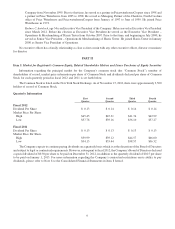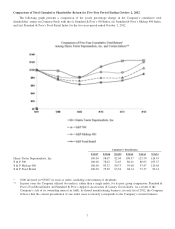Harris Teeter 2012 Annual Report Download - page 20
Download and view the complete annual report
Please find page 20 of the 2012 Harris Teeter annual report below. You can navigate through the pages in the report by either clicking on the pages listed below, or by using the keyword search tool below to find specific information within the annual report.historical experience, current and expected economic conditions and other factors believed to be reasonable under the
circumstances.Actual results could differ from those estimates. The Company constantly reviews the relevant, significant factors
and makes adjustments where the facts and circumstances dictate.
Management has identified the following accounting policies as the most critical in the preparation of the Company’s
financial statements because they involve the most difficult, subjective or complex judgments about the effect of matters that
are inherently uncertain.
Vendor Rebates, Credits and Promotional Allowances
Consistent with standard practices in the retail industry, the Company receives allowances from vendors through a variety
of programs and arrangements. Given the highly promotional nature of the retail supermarket industry, the allowances are
generally intended to defray the costs of promotion, advertising and selling the vendor’s products. Examples of such
arrangements include, but are not limited to, promotional, markdown and rebate allowances; cooperative advertising funds;
volume allowances; store opening discounts and support; and slotting, stocking and display allowances. The amount of such
allowances may be determined on the basis of (1) a fixed dollar amount negotiated with the vendor, (2) an amount per unit
purchased or as a percentage of total purchases from the vendor, or (3) amounts based on sales to the customer, number of stores,
in-store displays or advertising. The proper recognition and timing of accounting for these items are significant to the reporting
of the results of operations of the Company. The Company applies the authoritative guidance of the Securities and Exchange
Commission’s Staff Accounting Bulletin No. 104 (“SAB No. 104”) – Revenue Recognition, Subtopic 605-50 of the Financial
Accounting Standards Board (“FASB”) Accounting Standards Codification (“ASC”), and other authoritative guidance as
appropriate. Under SAB No. 104, revenue recognition requires, as a prerequisite, the completion of the earnings process and
its realization or assurance of realizability. Vendor rebates, credits and other promotional allowances that relate to Harris Teeter’s
buying and merchandising activities, including lump-sum payments associated with long-term contracts, are recorded as a
component of cost of sales as they are earned, the recognition of which is determined in accordance with the underlying
agreement with the vendor, the authoritative guidance and completion of the earning process. Portions of vendor allowances
that are refundable to the vendor, in whole or in part, by the nature of the provisions of the contract are deferred from recognition
until realization is reasonably assured.
The Company’s practices are in accordance with ASC Subtopic 605-50 and are based on the premise that the accounting
for these vendor allowances should follow the economic substance of the underlying transactions, which is evidenced by the
agreement with the vendor as long as the allowance is distinguishable from the merchandise purchase. Consistent with this
premise, the Company recognizes allowances when the purpose for which the vendor funds were intended and committed to
be used has been fulfilled and a cost has been incurred by the retailer. Thus, it is the Company’s policy to recognize the vendor
allowance consistent with the timing of the recognition of the expense that the allowance is intended to reimburse and to
determine the accounting classification consistent with the economic substance of the underlying transaction. Where the
Company provides an identifiable benefit or service to the vendor apart from the purchase of merchandise, that transaction is
recorded separately. For example, co-operative advertising allowances are accounted for as a reduction of advertising expense
in the period in which the advertising cost is incurred. If the advertising allowance exceeds the cost of advertising, then the
excess is recorded against the cost of sales in the period in which the related expense is recognized.
There are numerous types of rebates and allowances in the retail industry. The Company’s accounting practices with regard
to some of the more typical arrangements are discussed as follows. Vendor allowances for price markdowns are credited to the
cost of sales during the period in which the related markdown was taken and charged to the cost of sales. Slotting and stocking
allowances received from a vendor to ensure that its products are carried or to introduce a new product at the Company’s stores
are recorded as a reduction of cost of sales over the period covered by the agreement with the vendor based on the estimated
inventory turns of the merchandise to which the allowance applies. Display allowances are recognized as a reduction of cost
of sales in the period earned in accordance with the vendor agreement based on the estimated inventory turns of the merchandise
to which the allowance applies. Volume rebates by the vendor in the form of a reduction of the purchase price of the merchandise
reduce the cost of sales when the related merchandise is sold. Generally, volume rebates under a structured purchase program
with allowances awarded based on the level of purchases are recognized, when realization is assured, as a reduction in the cost
of sales in the appropriate monthly period based on the actual level of purchases in the period relative to the total purchase
commitment and adjusted for the estimated inventory turns of the merchandise. Some of these typical vendor rebate, credit and
promotional allowance arrangements require that the Company make assumptions and judgments regarding, for example, the
likelihood of attaining specified levels of purchases or selling specified volumes of products, the duration of carrying a specified
product and the estimation of inventory turns. Vendor allowances that have not been earned are recorded as either unearned
revenue or as an offset to the carrying value of inventory and totaled $16.9 million and $17.3 million as of October 2, 2012,
and October 2, 2011, respectively. The Company constantly reviews the relevant, significant factors and makes adjustments
16
























